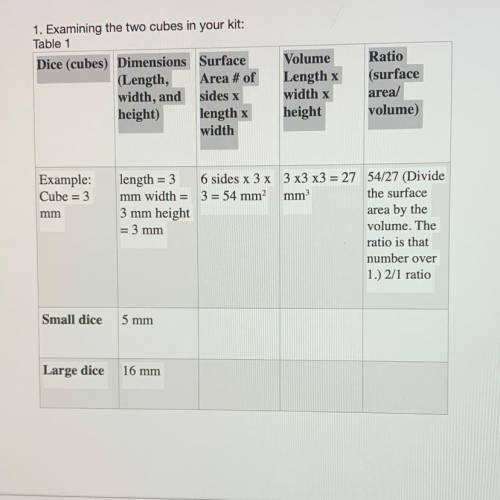
Biology, 20.11.2020 03:10 loveuncondition
1. Finish the table.
2. Consider the information in the chart above. (Remember: a higher ratio is better for diffusion.) As the volume increased:
A. What happened to the ratio?
B. If these cubes were cells, which ratio would make diffusion easier?
C. Which size cube would make a more efficient cell?


Answers: 3
Another question on Biology

Biology, 21.06.2019 12:30
Gregor mendel was the first scientist to use statistics to analyze scientific data before mandel's experiments, scientists believed that organisms acquired traits from their environment and pass them on to their offspring after mendel's discoveries were accepted scientists realized that traits passed to offspring were the result of genes being passed from parent to his parents this is an example of
Answers: 1

Biology, 21.06.2019 22:30
Which organisms have pharyngeal arches that develop from all three germ layers and go through the same development stages as embryos? 1.bird 2.ladybug 3.starfish 4.snake
Answers: 1

Biology, 22.06.2019 08:50
You are observing different types of cells in your science lab. one cell has many chloroplasts. what is the most likely function of this cell? a. energy production b. photosynthesis c. reproduction d. digestion
Answers: 1

Biology, 22.06.2019 17:30
98 points you will be galileo perform the experiment to determine if objects with different mass fall at the same, or different, rates in the air and in a vacuum. before you conduct your experiment, you need to form a hypothesis. a hypothesis is a prediction of what you think will happen in the experiment. the hypothesis is a statement that describes “if” a certain set of circumstances are present “then” there will be a specific result that will occur. record your hypothesis here: record the results from step one of the experiment (dropping the objects in the air): first trial: second trial: third trial: record the results from step two of the experiment (dropping the objects in a vacuum): first trial: second trial: third trial: did the experiment support your hypothesis? using the data from your experiment, describe why you believe your hypothesis was either proven or disproven. what forces were acting on the objects dropped in the air? what force was acting on the objects dropped in the vacuum? part two: comparing forces choose two forces and compare and contrast these forces. you must provide two ways that they are alike and two ways that they are different. you may make a list, write in paragraph form, or make a chart. choose two forces and compare and contrast these forces. these must be different forces than used in the prior question. provide two ways that they are similar and two ways that they are different. you may make a list, write it out, or make a chart.
Answers: 1
You know the right answer?
1. Finish the table.
2. Consider the information in the chart above. (Remember: a higher ratio is b...
Questions


Chemistry, 10.07.2019 00:30

Computers and Technology, 10.07.2019 00:30




Mathematics, 10.07.2019 00:30

History, 10.07.2019 00:30

English, 10.07.2019 00:30

Mathematics, 10.07.2019 00:30



Mathematics, 10.07.2019 00:30


World Languages, 10.07.2019 00:30

History, 10.07.2019 00:30


Mathematics, 10.07.2019 00:30




